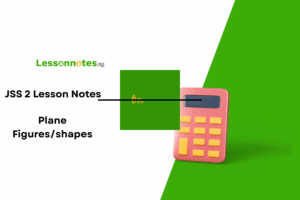Differentiation of Algebraic Function II SS3 Mathematics Lesson Note
Download Lesson NoteTopic: Differentiation of Algebraic Function II
- Differentiation of algebraic functions:
- Basic rules of differentiation such as sum and difference, product rule, quotient rule
- Maximal and minimum application.
Derivative of algebraic functions
Let f, u, v be functions such that f(x) = u(x) + v(x) f(x +x ) = u(x +x ) + v(x + x)
f(x + x) – f(x) = {u(x+ x) + v(x+ x) – v(x + x) – u(x) – v(x)}
= u (x +x ) – u(x) + v(x +x ) – v(x)
f(x + x) – f(x) = u(x +x)-u(x) + v(x +x ) – v(x)
Lim f(x + x) – f(x) = U1(x) + V1(x) if y = u + v and u and v are functions of x, then dy/dx = du/dx + dv/dx
Examples: Find the derivative of the following
- 2x3 – 5 x2 + 2 2)3x2 + 1/x 3)2x3 + 2x2 +1
Solution
- Let y = 2x3 – 5x2 + 2 dy/dx = 6x2 – 10x
- Let y = 3x2+ 1/x = 3x2 + x-1 dy/dx = 6x – x-2 = 6x – 1 x2
- Let y = 2x3 + 2x2 + 1
dy/dx=6x2 + 4x
Evaluation:
- If y = 3x4 – 2x3 – 7x + 5. Find dy/dx
- Find (8x3 – 5x2 + 6) Dx
Function of a function (chain rule)
Suppose that we know that y is a function of u and that u is a function of x, how do we find the derivative of y concerning x?
Given that y = f(x) and u = h(x), what is dy/dx?
dy/dx = , this is called the chain rule
Examples
Find the derivative of the following.
- y = (3x2 – 2)3
- y = (1 – 2x3)
- 5/(6-x2)3
Evaluation:
- Given that y = 1 find dy/dx
(2x + 3)4
- If y = (3x2 + 1)3, Find dy/dx
Product Rule
We shall consider the derivative of y = uv where u and v are functions of x. Let y = uv
Then y + y = (u +u )(v + v)
= uv + uv + vu +uv y = uv + uv + vu+ uv – uv y= uv + vu + uv y= uv + vu + uv
x x
As x =>0 ,u=> 0 , v=> 0
Lim y = Lim uv + Lim vu + Lim uv x=>0 x x=>0 x x=>0 x x=>0 x
Hence dy/dx= U dv + Vdu dxdx
Examples
Find the derivatives of the following.
- y = (3 + 2x) (1 – x) (b) y = (1 – 2x + 3x2) (4 – 5x2)
Solution
- y = (3 + 2x) (1 – x)
Let u = 3 + 2x and v = (1 – x) du/dx = 2 and dv/dx = -1
dv/dx = u dv + vdu dx dx
= (1 – x) 2 + (3 + 2x) (-1) = 2 – 2x – 3 – 2x
dy/dx = – 1 – 4x
- y = (1 – 2x + 3x2) (4 – 5x2)
Let u = (1 – 2x + 3x2) and v = (4 – 5x2) du/dx = -2 + 6x and dv/dx = – 10x
dy/dx = udv + vdu dxdx
= (1 – 2x + 3x2) (-10x) + (4 – 5x2) (- 2 + 6x)
= – 10x + 20x2 – 30x3 + (- 8 + 10x2 + 24x – 30x3)
= – 10x + 20x2 – 30x3 – 8 + 10x2 + 24x – 30x3
= 14x + 30x2 – 60x3 – 8
Evaluation
Given that (i) y = (5+3x)(2-x) (ii) y = (1+x)(x+2)3/2 ,find dy/dx
Quotient Rule: If y = u v then; dy = vdu– udv dxdxdx
v2
Examples:
Differentiate the following to x. (a) x2 + 1 (b) (x – 1) 2
1 – x2 √x
Evaluation: Differentiate with respect to x: (1) (2x + 3) 3 (2) √x
(x3– 4)2 √(x + 1)
Applications of differentiation:
There are many applications of differential calculus.
Examples:
- Find the gradient of the curve y = x3 – 5x2 + 6x – 3 at the point where x = 3.
Solution: Y = x3 – 5x2 + 6x – 3 dy/dx = 3x2 – 10x + 6
where x = 3; dy/dx = 3(32) – 10(3) + 6
= 27 – 30 + 6 = 3.
Find the coordinates of the point on the graph of y = 5x2 + 8x – 1 at which the gradient is – 2 Solution: Y = 5x2 + 8x – 1 dy/dx = 10x + 8
replace; dy/dx by – 2
10x + 8 = – 2 10x = – 2 – 8
x = -10/10 = -1
- Find the point at which the tangent to the curve y = x2 – 4x + 1 at the point (2, -3) Solution:
Y =x2 – 4x + 1
dy/dx = 2x – 4
at point (2, -3): dy/dx = 2(2) – 4 dy/dx = 0
tangent to the curve: y – y1 = dy/dx(x – x1)
y – (-3) = 0 (x- 2) y + 3 = 0
Evaluation:
- Find the coordinates of the point on the graph of y = x2 + 2x – 10 at which the gradient is 8.
- Find the point on the curve y = x3 + 3x2 – 9x + 3 at which the gradient is 15.
Velocity and Acceleration
Velocity: The velocity after t seconds is the rate of change of displacement to time.
Suppose; s = distance and t = time,
Then; Velocity = ds/dt
Acceleration: This is the rate of change of velocity compared with time.
Acceleration = dv/dt Example:
A moving body goes s metres in t seconds, where s = 4t2 – 3t + 5. Find its velocity after 4 seconds. Show that the acceleration is constant and find its value.
Solution:
S = 4t2 – 3t + 5 ds/dt = 8t – 3 velocity = ds/dt = 8(4) – 3
= 32 – 3
= 29 Acceleration: dv/dt = 8.
Maxima and Minimal
- Find the maximum and minimum value of y on the curve 6x – x2.
Solution:
y = 6x – x2 dy/dx = 6 – 2x equate dy/dx = 0
6 – 2x = 0
6 = 2x
X = 3
The turning point is (3, 9)
- Find the maximum and minimum of the function x3 – 12x + 2.
Solution:
Y =x3 – 12x + 2 dy/dx = 3x2 – 12
3x2 – 12 = 0
3x2 = 12
x2 = 12/3
x2 = 4 x = ± 2
minimum point occur when d2y/dx2> 0 maximum point occurs when d2y/dx2< 0 d2y/dx2= 6x
substitute x = 2; d2y/dx2 = 6 x 2 = 12
therefore: the function is minimum at point x = 2 and y = -14
substitute x = – 2; d2y/dx2 = 6(-2) = -12
therefore: the function is maximum at point x = – 2 and y = 18
Evaluation:
- A particle moves in such a way that after t seconds it has gone s metres, where s = 5t + 15t2 – t3
- Find the maximum and minimum value of y on the curve 4 –12x – 3x2.
General Evaluation
Use the product rule to find the derivative of
- y = x2 (1 + x)½
- y = √x (x2 + 3x – 2)2
- Find the derivative of y =(7x2 -5)3
- Using completing the square method find t if s=ut+1at2
2
- If 3 is a root of the equation x2 – kx +42=0 find the value of k and the other root of the equation
READING ASSIGNMENT: NGM for SS 3 Chapter 10 pages 90 -101,
WEEKEND ASSIGNMENT
OBJECTIVE
- Differentiate the function 4x4 + x3 – 5 (a)4x3 +3x2 (b)16x2 +3x2 (c)16x3 +3x2 (d)16x4 + 3x2
- Find d2y/dx2 of the function y = 3x5wrt x. (a) 15x3 (b) 45 x4 (c) 60x3 (d) 3x5 (e) 12x3
- If f(x) = 3x2 + 2/x find f1(x) (a) 6x + 2 (b) 6x + 2/x2 (c) 6x – 2/x2 (d)6x -2
- Find the derivative of 2x3 – 6x2 (a) 6x2 – 12x (b) 6x2 – 12x (c) 2x2 – 6x (d) 8x2 – 3x
- Find the derivative of x3 – 7x2 + 15x (a) x2 – 7x + 15 (b) 3x2 – 14x + 15 (c) 3x2 + 7x + 15 (d) 3x2 – 7x + 15
THEORY
- Differentiate with respect to x. y2 + x2 – 3xy = 4





















